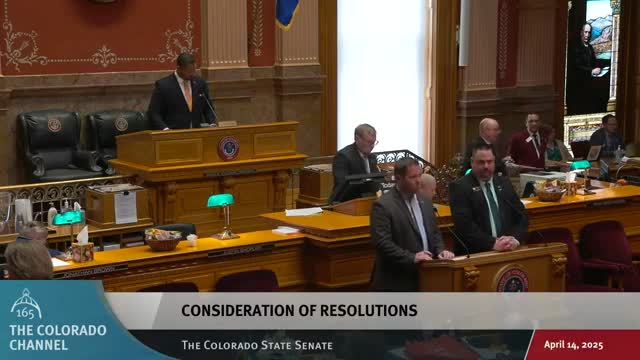Colorado Senate approves joint resolution to place Sand Creek Massacre memorial on State Capitol west grounds
April 14, 2025 | Senate, Committees, Legislative, Colorado
This article was created by AI summarizing key points discussed. AI makes mistakes, so for full details and context, please refer to the video of the full meeting. Please report any errors so we can fix them. Report an error »

The Colorado Senate on April 14 adopted House Joint Resolution 1024, approving a plan to install a memorial to victims of the Sand Creek Massacre on the west grounds of the State Capitol and to place the Union Soldier statue on long-term loan to the Department of Military and Veterans Affairs.
The resolution acknowledges the Sand Creek Massacre of Nov. 29, 1864, in which the text notes about 230 Cheyenne and Arapaho people were killed, mostly women, children and elders, and approves the design and location recommended by the State Capitol Building Advisory Committee, the Capital Development Committee and the governor.
Sen. Sandra Mullica (D) moved the resolution and framed it as recognition of historical truth and a step toward healing, saying, "This was not a battle. It was a massacre." She thanked tribal delegations in the chamber and urged that the memorial "promote cross-cultural understanding, and educate the public about the massacre and the events surrounding it to foster healing."
Sen. Chris Gonzales (D) and Sen. Jessie Danielson (D) spoke in support, noting the long advocacy and consultation with Cheyenne and Arapaho leaders that produced the memorial design and placement recommendation. Danielson described the memorial as "the product of years of effort by the people in this room and the communities that they represent." The Senate also recognized tribal guests from the Cheyenne and Arapaho nations who attended the session.
The resolution text, read in full on the floor, recounts the events at Sand Creek, references prior state actions including Colorado Senate Joint Resolution 1997 and the 2009 interpretive plaque, and notes that the Capitol Building Advisory Committee and the Capital Development Committee approved the new design on Nov. 25, 2024. It directs that copies of the joint resolution be transmitted to the governor, the advisory and development committees, the Sand Creek Massacre Memorial Committee, the Sand Creek Massacre Foundation, the affected tribal nations, History Colorado, the Department of Military and Veterans Affairs, and the Department of Personnel.
Senators voted to adopt H.J.R. 1024 by voice and recorded roll call as 33 ayes, 0 no, 0 absent and 2 excused. The Senate added the current roll call as cosponsors and recessed briefly to greet the tribal guests after the vote.
Why it matters: the resolution formalizes placement of a memorial to one of Colorado's most consequential historical events on prominent state property and memorializes a tribal-requested design after multi-year consultation. The action also provides for the long-term loan of an existing Union Soldier statue to the Department of Military and Veterans Affairs for display elsewhere, removing that statue from the Capitol site tied to the new memorial.
The measure now proceeds as a concurrent resolution approved by the General Assembly and will be transmitted to the listed agencies for implementation and coordination.
The resolution acknowledges the Sand Creek Massacre of Nov. 29, 1864, in which the text notes about 230 Cheyenne and Arapaho people were killed, mostly women, children and elders, and approves the design and location recommended by the State Capitol Building Advisory Committee, the Capital Development Committee and the governor.
Sen. Sandra Mullica (D) moved the resolution and framed it as recognition of historical truth and a step toward healing, saying, "This was not a battle. It was a massacre." She thanked tribal delegations in the chamber and urged that the memorial "promote cross-cultural understanding, and educate the public about the massacre and the events surrounding it to foster healing."
Sen. Chris Gonzales (D) and Sen. Jessie Danielson (D) spoke in support, noting the long advocacy and consultation with Cheyenne and Arapaho leaders that produced the memorial design and placement recommendation. Danielson described the memorial as "the product of years of effort by the people in this room and the communities that they represent." The Senate also recognized tribal guests from the Cheyenne and Arapaho nations who attended the session.
The resolution text, read in full on the floor, recounts the events at Sand Creek, references prior state actions including Colorado Senate Joint Resolution 1997 and the 2009 interpretive plaque, and notes that the Capitol Building Advisory Committee and the Capital Development Committee approved the new design on Nov. 25, 2024. It directs that copies of the joint resolution be transmitted to the governor, the advisory and development committees, the Sand Creek Massacre Memorial Committee, the Sand Creek Massacre Foundation, the affected tribal nations, History Colorado, the Department of Military and Veterans Affairs, and the Department of Personnel.
Senators voted to adopt H.J.R. 1024 by voice and recorded roll call as 33 ayes, 0 no, 0 absent and 2 excused. The Senate added the current roll call as cosponsors and recessed briefly to greet the tribal guests after the vote.
Why it matters: the resolution formalizes placement of a memorial to one of Colorado's most consequential historical events on prominent state property and memorializes a tribal-requested design after multi-year consultation. The action also provides for the long-term loan of an existing Union Soldier statue to the Department of Military and Veterans Affairs for display elsewhere, removing that statue from the Capitol site tied to the new memorial.
The measure now proceeds as a concurrent resolution approved by the General Assembly and will be transmitted to the listed agencies for implementation and coordination.
View full meeting
This article is based on a recent meeting—watch the full video and explore the complete transcript for deeper insights into the discussion.
View full meeting
